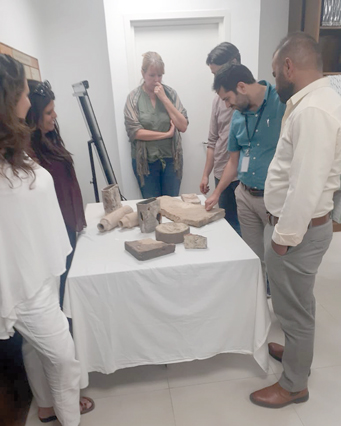AMMAN — To increase understanding of Jordan’s archaeological heritage, two archaeologists, Jihad Haron and Douglas Clark, introduced a manual titled “Pottery of Jordan” last Saturday at American Centre of Research (ACOR) during a workshop about The Levantine Ceramics Project (LCP).
The LCP is an open-access resource for the study of Levantine pottery, cultures, societies, economies and religions from the Neolithic era (around 5,500 BC), until the end of the Ottoman Empire, the organisers said.
The workshop was launched in the memory of Professor Thomas Parker (1950-2021) with support of ACOR and American Schools of Overseas Research (ASOR).
“We needed to customise this information for Jordanian archaeology students and employees of the Department of Antiquities,” Haron, ACOR’s associate director, said, adding that the manual will be available in English and Arabic in PDF format, while hard copies will be distributed to university libraries and research centres.
“This project is a very good idea to boost collaboration between scholars and to modify their definitions about pottery,” noted Micaela Sinibaldi, a visiting lecturer at Warsaw University and a moderator of the workshop with Ian Jones.
The LCP is one of ASOR’s related projects, Jones, who came from University of California San Diego, added.
Talking about ceramic building material, Craig Harvey from Western University, Canada, said that he has been analysing bricks, heating pipes and water pipes in Humayma, some 280km south of Amman.
“In terms of using of ceramic building material, the east is very different from the west due to its very dry climate,” Harvey said, noting that in Humayma he found the ceramic building material in aqueducts, baths and churches.
Lots of tiles were shipped from Cyprus, Harvey continued, adding that sizes of ceramic building material can indicate a cultural exchange as Nabataeans used the Roman standards for bricks.
Italian archaeologist Raffaella Pappalardo highlighted pottery from Jerash that covered the Byzantine, Ummayad and early Abbasid periods.
“Jerash is, I must say, a city of pottery,” Pappalardo said. “If one has even a small excavation in Jerash they will find lots of remains of pottery,” she said.
Jerash’s orange and red ware is a specific type of pottery produced in the area, and it is very well fired, Pappalardo said.
Talking about Khirbat Al Mukhayyat, a site located near Madaba, Assistant Professor from Wilfred Laurier University Debra Foran said that a number of cooking pots and wares have been excavated at the site.
Regarding the LCP, Foran said that the project taught her to think systematically.
“We have a database for the cooking pots, but accessibility of the LCP is an added value,” Foran said.
